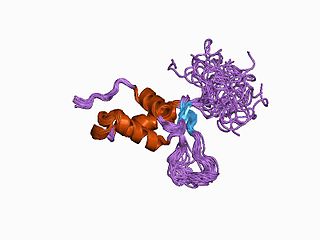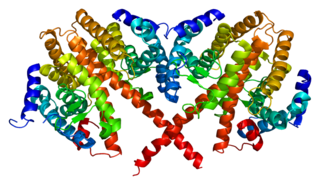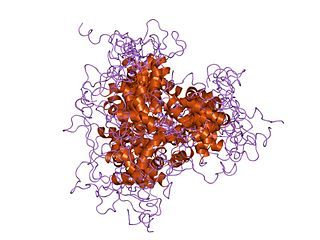Forkhead box protein A2 (FOXA2), also known as hepatocyte nuclear factor 3-beta (HNF-3B), is a transcription factor that plays an important role during development, in mature tissues and, when dysregulated or mutated, also in cancer. [5]
Forkhead box protein A2 (FOXA2), also known as hepatocyte nuclear factor 3-beta (HNF-3B), is a transcription factor that plays an important role during development, in mature tissues and, when dysregulated or mutated, also in cancer. [5]
FOXA2 belongs to a subfamily of the Forkhead box (FOX) transcription factors, the other members being FOXA1 and FOXA3. This subfamily of mammalian FOX proteins was first identified because of their ability to bind DNA in rat liver nuclear extracts. The proteins were therefore originally named hepatocyte nuclear factor 3 alpha, beta and gamma. [6] These transcription factors contain a forkhead domain (also known as the winged-helix domain) flanked by sequences necessary for nuclear localization [7] Their N- and C-termini are also conserved and serve as transactivation domains. [8] [9]
FOXA transcription factors have “pioneering” property, i.e. they can directly bind to condensed chromatin. [5] This feature has been observed both in vitro and in vivo, where FOXA transcription factors can bind nucleosome-bound target DNA sequences. [10] [11] The pioneering property is conferred by the factors’ highly conserved DNA-binding domain, which is structurally similar to the linker histones H1 and H5 [12] [13] This feature enables FOXA2 to access closed chromatin and displace linker histones. In this way, FOXA2 promotes local chromatin opening, permits the recruitment of alternative histones and facilitates the subsequent binding of other transcription factors. [10] [14] [15] Thus, FOXA2 have important roles in cell type specification by promoting chromatin accessibility for the binding of lineage- or tissue-specific factors [16] The FOXA factors also facilitate the maintenance of cell identity by bookmarking cell type-specific genes so that these genes can be rapidly reactivated after cytokinesis. [17] One example is that ectopic expression of FOXA2 together with HNF4A drives transdifferentiation of fibroblasts to hepatocyte-like cells. [18]
Consistent with its role as a pioneering transcription factor, FOXA2 is expressed in early development and essential for the development and homeostasis of various cell types and tissues. In mice, Foxa2 expression emerges in the primitive streak and node at embryonic day (E) 6.5, and in the mesoderm and definitive endoderm at E7.5. [19] [20] Its expression is subsequently maintained in endoderm-derived tissues, including the pancreas, liver, prostate, thyroid and lung, throughout development and in mature tissues. [7] In addition, Foxa2 is expressed in ectoderm-derived neural tissues. [21] Foxa2 knockout is embryonically lethal to mice, which die between E10 and E11 and show defects in all three germ layers. [22] [23] Mice with heterozygosity for Foxa2 knockout are viable and exhibit a phenotype similar to Parkinson’s disease upon aging. [24] Conditional knockout studies show that Foxa2 is important for the formation of pancreatic islets and maturation of alpha and beta cells, thereby being essential for glucose homeostasis. [25] [26]
Dysregulation of FOXA transcription factors have been linked to several types of human cancers, including acute myeloid leukemia and cancer of the esophagus, lung, thyroid, pancreas, breast and prostate. [27] Single nucleotide polymorphisms in the FOXA2 gene are associated with hepatocellular carcinoma, especially in males. This association has been replicated in mice and may depend on androgen receptor-mediated regulation [28]
Transdifferentiation, also known as lineage reprogramming, is the process in which one mature somatic cell is transformed into another mature somatic cell without undergoing an intermediate pluripotent state or progenitor cell type. It is a type of metaplasia, which includes all cell fate switches, including the interconversion of stem cells. Current uses of transdifferentiation include disease modeling and drug discovery and in the future may include gene therapy and regenerative medicine. The term 'transdifferentiation' was originally coined by Selman and Kafatos in 1974 to describe a change in cell properties as cuticle producing cells became salt-secreting cells in silk moths undergoing metamorphosis.
FOXproteins are a family of transcription factors that play important roles in regulating the expression of genes involved in cell growth, proliferation, differentiation, and longevity. Many FOX proteins are important to embryonic development. FOX proteins also have pioneering transcription activity by being able to bind condensed chromatin during cell differentiation processes.
HMGN proteins are members of the broader class of high mobility group (HMG) chromosomal proteins that are involved in regulation of transcription, replication, recombination, and DNA repair.
HNF4 is a nuclear receptor protein mostly expressed in the liver, gut, kidney, and pancreatic beta cells that is critical for liver development. In humans, there are two paralogs of HNF4, HNF4α and HNF4γ,encoded by two separate genes HNF4A and HNF4G respectively.

Forkhead box protein C2 (FOXC2) also known as forkhead-related protein FKHL14 (FKHL14), transcription factor FKH-14, or mesenchyme fork head protein 1 (MFH1) is a protein that in humans is encoded by the FOXC2 gene. FOXC2 is a member of the fork head box (FOX) family of transcription factors.
Hepatocyte nuclear factors (HNFs) are a group of phylogenetically unrelated transcription factors that regulate the transcription of a diverse group of genes into proteins. These proteins include blood clotting factors and in addition, enzymes and transporters involved with glucose, cholesterol, and fatty acid transport and metabolism.

Histone deacetylase 1 (HDAC1) is an enzyme that in humans is encoded by the HDAC1 gene.

Hepatocyte nuclear factor 4 alpha (HNF4A) also known as NR2A1 is a nuclear receptor that in humans is encoded by the HNF4A gene.

HNF1 homeobox A, also known as HNF1A, is a human gene on chromosome 12. It is ubiquitously expressed in many tissues and cell types. The protein encoded by this gene is a transcription factor that is highly expressed in the liver and is involved in the regulation of the expression of several liver-specific genes. Mutations in the HNF1A gene have been known to cause diabetes. The HNF1A gene also contains a SNP associated with increased risk of coronary artery disease.

HNF1 homeobox B, also known as HNF1B or transcription factor 2 (TCF2), is a human gene.

Forkhead box C1, also known as FOXC1, is a protein which in humans is encoded by the FOXC1 gene.

Transcription factor GATA-5 is a protein that in humans is encoded by the GATA5 gene.

Forkhead box D3 also known as FOXD3 is a forkhead protein that in humans is encoded by the FOXD3 gene.

Neurogenin-3 (NGN3) is a protein that in humans is encoded by the Neurog3 gene.

Forkhead box protein A1 (FOXA1), also known as hepatocyte nuclear factor 3-alpha (HNF-3A), is a protein that in humans is encoded by the FOXA1 gene.

Hepatocyte nuclear factor 3-gamma (HNF-3G), also known as forkhead box protein A3 (FOXA3) or transcription factor 3G (TCF-3G) is a protein that in humans is encoded by the FOXA3 gene.

Forkhead box I1 is a protein that in humans is encoded by the FOXI1 gene.

Forkhead box protein J1 is a protein that in humans is encoded by the FOXJ1 gene. It is a member of the Forkhead/winged helix (FOX) family of transcription factors that is involved in ciliogenesis. FOXJ1 is expressed in ciliated cells of the lung, choroid plexus, reproductive tract, embryonic kidney and pre-somite embryo stage.
Pioneer factors are transcription factors that can directly bind condensed chromatin. They can have positive and negative effects on transcription and are important in recruiting other transcription factors and histone modification enzymes as well as controlling DNA methylation. They were first discovered in 2002 as factors capable of binding to target sites on nucleosomal DNA in compacted chromatin and endowing competency for gene activity during hepatogenesis. Pioneer factors are involved in initiating cell differentiation and activation of cell-specific genes. This property is observed in histone fold-domain containing transcription factors and other transcription factors that use zinc finger(s) for DNA binding.
Kenneth S. Zaret is a Professor in the Department of Cell and Developmental Biology at the Perelman School of Medicine, University of Pennsylvania, and Director of the Institute for Regenerative Medicine at UPenn. He is a recipient of the Hans Popper Basic Science Award from the American Association for the Study of Liver Diseases and the American Liver Foundation, a fellow of the American Association for the Advancement of Science, and a member of the American Association of Arts and Sciences, the European Molecular Biology Organization, and the National Academy of Sciences.
This article incorporates text from the United States National Library of Medicine, which is in the public domain.